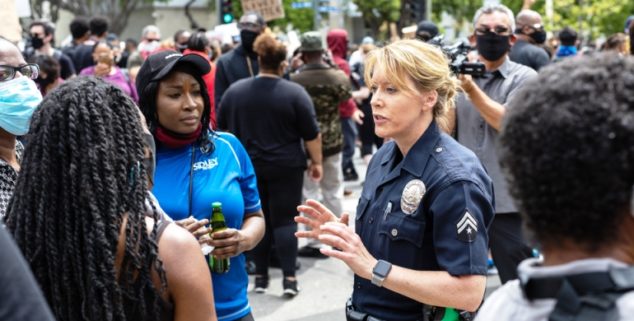Opinion
Needed: a true safety strategy — not the same failed approaches
 Participants in a protest against police use-of-force policies speak with an LAPD officer. (Photo: John Doukas, via Shutterstock)
Participants in a protest against police use-of-force policies speak with an LAPD officer. (Photo: John Doukas, via Shutterstock)The terrible gun violence in Sacramento shows, once again, that we cannot delay our effort to make Californians safer. Sadly, this task is being made harder by individuals making false claims about the incident to advance an incarceration-first agenda that is both ineffective and very expensive.
Our collective well-being and safety depend on staying the course toward a new, more effective shared safety strategy that works for all Californians.
In recent years, California voters have repeatedly declared their preference for public safety based on prevention and healing rather than incarceration, and our state’s policies have moved slowly but decisively in that direction as a result.
For nearly half a century now, California has responded to every public safety challenge with the same “solution”: incarceration
But with some types of violent crime on the rise here — as they are across the nation- – opponents of progress have been scheming to restore the narrow tough-on-crime policies that once gave our state the largest prison population in the nation.
Heeding their calls would be a terrible mistake.
At this crucial moment, what California really needs is to fully embrace public safety strategies that will prevent crime by directly addressing its root causes and setting an example for the rest of the nation. What California — and America—need now is a comprehensive safety plan.
If the COVID pandemic has taught us anything, it is that the assumptions and systems we used to rely on cannot deliver the kind of safety that we expect. Whether it is safety from crime, or from disease, or homelessness, or education, the old ways no longer seem up to the task. This is especially apparent in the criminal justice system.
For nearly half a century now, California has responded to every public safety challenge with the same “solution”: incarceration. Along with the rest of America, in the 1970s and 1980s we followed the lead of Richard Nixon and responded to urban unrest after centuries of racial discrimination with a War on Crime.
When crack cocaine upended Black communities in the 1990s, we transitioned to a War on Drugs that viewed addiction as a crime demanding longer sentences rather than as a disease that required treatment. As a result, California jails and prisons swelled — as did their budgets — and crime rates in some cities skyrocketed to historic highs.
In the six years since it went into effect, Proposition 47 has reallocated more than $600 million in savings from reduced prison costs.
Today, with mass shootings roiling our cities, the political debate is centered on gun control rather than solutions to address the systemic and social conditions that breed a culture of hated and violence. The proposed solutions still disproportionally criminalize and harm the very communities that experience the brunt of the trauma.
None of these past “wars” made us any safer. Starting a new domestic war on crime using our criminal justice system won’t either.
Law enforcement continues to demand more money for the same failed tactics that perpetuate cycles of crime, while the immediate needs of victims go unmet. Meanwhile, so many public resources are absorbed by prison overhead costs that little is left to help remove barriers for individuals returning to our communities after incarceration — an approach that can literally prevent more crime from taking place.
Fortunately, the past decade has revealed a number of alternatives to incarceration that are effective in reducing crime and violence, and which can be dramatically scaled up to address our current crisis.
Last November, Arnold Ventures and researchers at the John Jay College of Criminal Justice released a comprehensive study documenting the efficacy of some of these alternatives, which include improvements to the physical environment (more green spaces, better housing, improved lighting), expanded community-based violence intervention programming, supports for high-risk youth (mentorship, job training, educational enhancements), access to substance use treatment, greater financial stability, a more transparent and trustworthy justice system, and reduced access to guns.
Many of these things can be easily achieved by investing in the network of community-based organizations that are already providing services for communities in need. These organizations, which are deeply connected to the neighborhoods they serve and often led by people who have lived the same challenges, are ideally positioned to provide things like substance use and mental health treatment, housing support, and reentry programming.
In the six years since it went into effect, Proposition 47 has reallocated more than $600 million in savings from reduced prison costs to dozens of these organizations across the state. But so much more is needed — and California continues to spend more than $14 billion each year on prisons.
We applaud the governor and other state leaders who have demonstrated their commitment to system reform and holding people accountable when necessary. Now, however, we have an obligation to commit to a 21st century public safety system that will be far more effective at keeping us safe and protecting our shared well-being.
California must disregard the dangerous, politically-motivated rhetoric of those who would lead us backward to save themselves. Instead, we must seize this historic opportunity to create a real shared safety system that works for us all.
—
Editor’s Note: Tinisch Hollins is the executive director of Californians for Safety and Justice
Want to see more stories like this? Sign up for The Roundup, the free daily newsletter about California politics from the editors of Capitol Weekly. Stay up to date on the news you need to know.
Sign up below, then look for a confirmation email in your inbox.

Leave a Reply